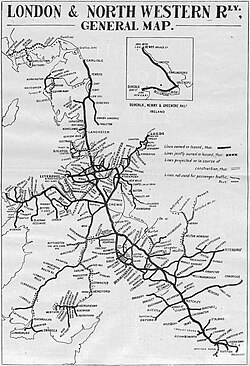
Back London and North Western Railway Catalan London and North Western Railway German Ferrocarril de Londres y del Noroeste Spanish London and North Western Railway French London and North Western Railway Italian London and North Western Railway Portuguese London and North Western Railway Russian London and North Western Railway SIMPLE
 | |
 1920 map of the railway | |
| Overview | |
|---|---|
| Headquarters | Euston railway station |
| Dates of operation | 16 July 1846 – 31 December 1922 |
| Predecessor | Grand Junction Railway London and Birmingham Railway Manchester and Birmingham Railway |
| Successor | London, Midland and Scottish Railway |
| Technical | |
| Track gauge | 4 ft 8+1⁄2 in (1,435 mm) |
| Length | 2,066 miles 6 chains (3,325.0 km) (1919)[1] |
| Track length | 5,818 miles 59 chains (9,364.4 km) (1919)[1] |
The London and North Western Railway (LNWR, L&NWR) was a British railway company between 1846 and 1922. In the late 19th century, the LNWR was the largest joint stock company in the world.[2][3][4][5]
Dubbed the "Premier Line", the LNWR's main line connected four of the largest cities in England; London, Birmingham, Manchester and Liverpool, and, through cooperation with their Scottish partners, the Caledonian Railway also connected Scotland's largest cities of Glasgow and Edinburgh. Today this route is known as the West Coast Main Line. The LNWR's network also extended into Wales and Yorkshire.
In 1923, it became a constituent of the London, Midland and Scottish (LMS) railway, and, in 1948, the London Midland Region of British Railways.
- ^ a b The Railway Year Book for 1920. London: The Railway Publishing Company Limited. 1920. p. 176.
- ^ Reed, Michael. "Moon, Sir Richard, first baronet (1814–1899)". Oxford Dictionary of National Biography (online ed.). Oxford University Press. doi:10.1093/ref:odnb/45712. (Subscription or UK public library membership required.)
- ^ Bradley, Simon (2016). The Railways: Nation, network & people (Paperback ed.). London: Profile Books. p. 426. ISBN 9781846682131. "The LNWR was the largest joint-stock company of its time, with a capitalisation of over £29 million in 1851".
- ^ Sheppard, Richard; Roberts, David. "Basil Oliver Moon BA". Magdalen College, Oxford. The Slow Dusk. Retrieved 19 May 2023.
- ^ "London and North Western Railway Company". Institution of Mechanical Engineers. Retrieved 18 May 2023.